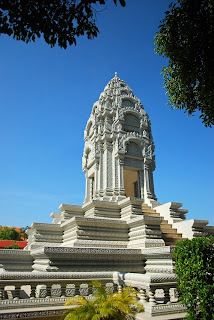 Hi and welcome.
Hi and welcome.This is the penultimate posting of Cambodia. It is very famous for the incredible ancient temple complex of Ankor. But there are also some lovely, modern, temples and I will show you some shots from three of them; all situated in Phnom Penh.
I hope you enjoy them. The weather was fantastic for showing them off at their best. Next time, the grand finale, Angkor Wat itself.
The Royal Palace is, as the name suggests, the
official residence of the King of Cambodia. In
Khmer its full name is "Preah Barom Reachea
Vaeng Chaktomuk". This lovely building is
the Royal Throne Hall

This is the Hor Samran Phirun, "the Pavilion
where one sleeps peacefully". It is used to
house musical instruments and procession
implements. It is where the king rests and then
mounts an elephant for Royal processions.
It was built in 1917

Chanchhaya, or, also known as Moonlight, Pavilion.
It is used for Royal banquets and as a venue for
the Royal dancers.

Back to the Royal Palace. It is used as an audience
hall, for coronations and diplomatic meetings

Built from east to west the best
time to visit and take photos is
early morning. There's also more
of a chance that there will not be
too many other visitors.

The lady behind the veil. I'm talking about
the building, not the lady peeking behind
the veil; that's my wife!

This is what she was looking at, the Napoleon 111
Pavilion. Somewhat in contrast with all the other
buildings, this was the very first permanent structure
on the site. It was built for Empress Eugenie of France,
the wife of Napoleon 111 in 1876. Napoleon gifted it
to the King of Cambodia.

This is my Empress, Daniela

Very old and somewhat damaged frescoes. But
still very beautiful

The belfry, used to signal
the opening and closing of the
temple as well as during ceremonies.
It is in the Silver Pagoda part of the
Palace

The stupa of King
Ang Doung, 1845 - 1860

Reflections

The stupa of Princess
Kantha Bopha. She was the
daughter of the former King
Sihanouk. Tragically she died
aged only four from leukaemia

Final photo of the Palace shows
Wat Preah Keo Morokat. This
is the Silver Pagoda that houses
the Emerald Buddha 5329 silver tiles
cover the floor. It is full of precious objects,
many of which were donated by important
Buddhists.

I went to the Killing Fields of the Khmer Rouge
at Choeung Ek, just outside Phnom Penh. This
building is the memorial stupa to all those who
died during the genocide. I have included it
because it is a temple for the victims to rest
and be at peace according to Cambodian tradition.

This is Wat Ounalom. It is the most important
Wat of Phnom Penh and is the centre of Buddhism
in Cambodia. It was established in 1443 and is
believed to contain, in a stupa, an eyebrow hair of
the Buddha

Beautiful architecture

I'm not sure of the significance of this statue
but I loved its setting, nestled in the greenery

Another gorgeous roof

This is the most decorated-with-lights altar
that I have seen and photographed!

One of the main buildings

Fantastic gateway

Exit to the road and riverfront (Tonle Sap river)

I don't think he drinks the beer! Temple elephant
at Wat Phnom

It is known as the Temple of
the Mountain. It stands at 27
metres and was built in 1373
This is the shrine at the bottom
of the main Stupa

The altar inside the main hall, richly decorated

Proud lions, I think they are lions. They are
very stylised

Apsaras, celestial maidens, heavenly beings

Parking place for the birds in
cage 3!

Classic depiction of an apsara
Do come back for Angkor Wat.